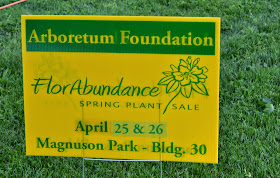And now for Part Two of the Tale of Juggling Trees and Shrubs. Read Part One here, in which I transplant a Hinoki cypress from one part of my garden to another in order to make room for a Magnolia macrophylla and a Japanese maple.
I've also been hankering for a Stewartia pseudocamellia, a tree with beautiful white Camellia-like flowers and peeling bark that would be at home in a part shade spot in the back garden. In order to plant it, I needed to take out the smaller of my two Indian plum trees. Oemleria cerasiformis is a wonderful Pacific Northwest native small tree, one of the first to flower in late winter, but not only do I already have a larger one growing in a different bed, but my neighbor has an even bigger one just on the other side of my fence, so we don't really need three in the immediate vicinity.
On a recent visit to Bellevue Nursery, I found a very nice 5 1/2-foot tall Stewartia (Hooray for yet another 20% off coupon), but to get it into position (with Nigel's help and a hand trolley), I was going to have to temporarily remove some shrubs -- a Viburnum trilobum 'Red Wing,' a native Euonymus atropurpureus, and a Hamamelis 'Jelena.'
So, one recent weekend I did a lot of digging and then Nigel helped me wrestle the new tree into place behind the stream. Although it's over 5 feet tall, it looks small next to the enormous Douglas firs that tower over my garden.
 |
| It's got plenty of room to grow upwards! |
 |
| The slender trunk is already showing signs of the lovely peeling bark that Stewartia is known for |
 |
| Stewartia flowers -- it's loaded with buds, which hopefully will open soon |
Myrica californica was one of the first trees I planted here, in the hopes that it would provide screening from neighbors' blue tarp-laden yards. It's much bigger than it was when first planted, but it still hasn't topped the height of the fence. I saw one last year at the Elisabeth C. Miller Garden in North Seattle, and theirs was huge, so I have high hopes for the future. According to what I've read online, it should eventually reach a height of 20-30 feet.
 |
| Myrica californica and Leycesteria formosa |
Since I had a blank slate there for a short time, I decided to take the opportunity to re-arrange the perennials that were growing beside the stream. I haven't been happy with the tall grasses that I planted too close to the water, because in the shady spot they had a tendency to flop and droop their blades and inflorescences into the water. They also very quickly became much too crowded. So I dug out everything, found a new home for some of the grasses, and then replanted the Primula 'Bellarina,' Carex 'Ice Dance,' and Euphorbia. I also planted several large healthy clumps of a nice Epimedium that I love, which used to live in the front shade bed, but got removed when I replanted that bed recently. Now it's much tidier and I'm much happier.
But I did end up with some shrubs that I now don't quite know what to do with.
 |
| Viburnum trilobum 'Red Wing' has now gone begging for a home in another bed. Somewhere. |
 |
| I love its reddish new growth, so I really need to find a spot for it |
 |
| The Euonymus atropurpureus, aka Eastern wahoo, has yet to show me the cool blooms that made me want it in the garden. |
 |
| Indian Plum, removed to make room for the Stewartia, is looking a bit bedraggled. I'll probably give it away on craigslist. |
Stay tuned for Part Three, in which I remove one tree to make room for another. Again.

















































